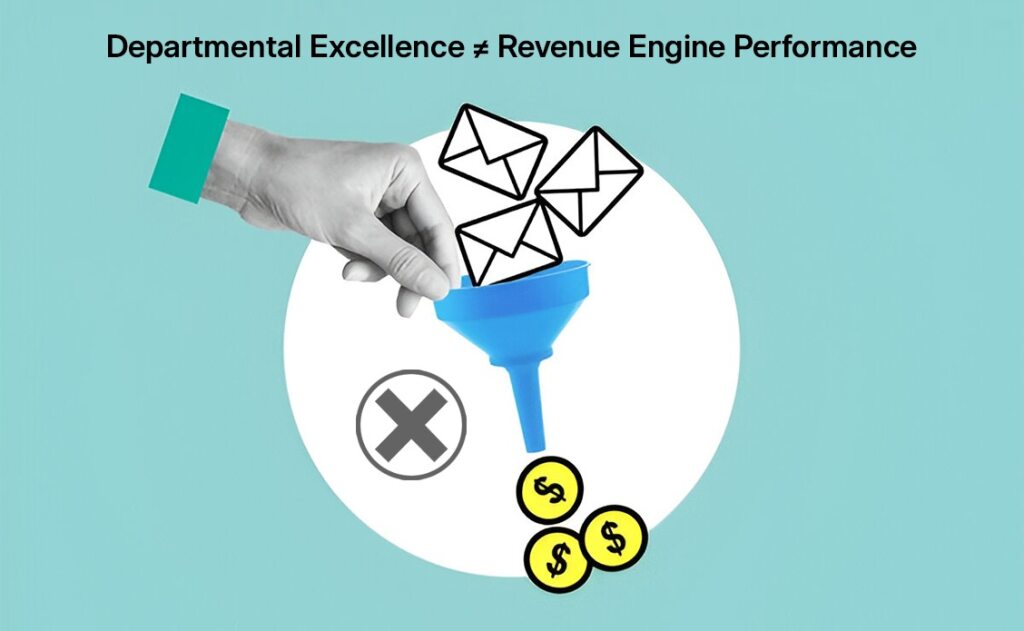The Revenue Plateau Mystery:
Your sales team is crushing activity metrics. Marketing is generating more leads than ever. Customer success is hitting retention targets. Yet somehow, revenue growth is flatlining at 15% when your board expects 40%+.
Sound familiar? I’ve diagnosed this exact scenario across 60+ B2B companies in the past two years. The symptoms are always the same: impressive departmental performance that doesn’t translate to enterprise-level results. The diagnosis? Your GTM functions are optimizing in isolation instead of operating as an integrated engine.
This isn’t an execution problem, it’s an architecture problem. Most founders build GTM like a relay race where marketing hands off to sales, sales hands off to customer success, and everyone hopes the baton doesn’t get dropped. But modern GTM requires orchestration, not handoffs.
Departmental Excellence ≠ Revenue Engine Performance
At NextAccel, we’ve rebuilt GTM engines for companies ranging from $5M to $150M ARR. Here’s the systematic approach to diagnosing and fixing your revenue engine problems.
Problem #1: Your Funnel Isn’t Actually a Funnel
The Reality Check Question:
“Can you trace a $500K deal from first marketing touchpoint to expansion revenue without involving three different systems and two manual handoffs? If not, you don’t have a funnel—you have departmental silos.”
Marketing generates MQLs using one definition of “qualified.” Sales requalifies leads using completely different criteria. Customer Success measures expansion against unrelated success metrics. Meanwhile, your “funnel conversion rate” is actually measuring three different processes that barely connect.
Real Diagnostic: I worked with a $25M ARR SaaS company celebrating 40% MQL-to-SQL conversion rates. But when we mapped their full buyer journey, we discovered 60% of SQLs stalled in sales qualification, and 70% of closed-won customers never expanded. Their “high-performing” funnel was actually three separate funnels with massive leakage between stages.
The Fix – Unified Revenue Operations:
- Single source of truth for prospect progression across all touchpoints
- Shared definitions for qualification criteria across all teams
- Automated handoff protocols that preserve context and momentum
- Cross-functional KPIs that measure end-to-end performance
Problem #2: You’re Measuring Activities, Not Outcomes
The Vanity Metrics Trap:
“Show me your GTM dashboard and I’ll predict your revenue predictability. If you’re tracking ‘leads generated’ instead of ‘deals influenced,’ you’re optimizing for the wrong end of the equation.”
Teams celebrate hitting MQL targets while pipeline stagnates. Sales reps book demo quotas while deal sizes shrink. Customer success maintains NPS scores while expansion revenue flatlines. Everyone’s hitting their numbers, but enterprise metrics are declining.
The NextAccel Outcome-Based GTM Framework:
Marketing Accountability Shift:
- From: Lead volume and cost-per-lead
- To: Pipeline influence and revenue attribution
Sales Performance Revolution:
- From: Activity metrics and meeting quotas
- To: Deal velocity and win rate optimization
Customer Success Value Focus:
- From: NPS scores and support ticket resolution
- To: Net revenue retention and expansion pipeline creation
Monthly Revenue Engine Reviews:
- Pipeline coverage ratio (3x+ target for predictable growth)
- Velocity trends by deal stage and source
- Win rate analysis by competitor and use case
- Expansion revenue as percentage of new bookings
Problem #3: Your Teams Are Playing Different Games
The Misalignment Reality:
“If marketing, sales, and customer success have different definitions of your ideal customer profile, you’re not running a GTM engine—you’re running three separate businesses that happen to share a logo.”
Marketing targets broad demographics to maximize lead volume. Sales prioritizes deals that close fastest to hit quarterly targets. Customer success focuses on accounts with highest engagement scores. The result? Expensive customer acquisition with poor retention and limited expansion potential.
The GTM Alignment Protocol:
Unified ICP Development:
- Cross-functional workshops to define buyer personas based on actual closed-won data
- Behavioral and firmographic criteria that predict both sales velocity and customer success
- Use case prioritization based on deal size, sales cycle, and expansion potential
Account-Based GTM Orchestration:
- Target account selection criteria shared across all teams
- Coordinated outreach sequences that span marketing content, sales touchpoints, and success onboarding
- Revenue attribution that credits cross-functional collaboration
Problem #4: You’re Building for Today’s Customer Instead of Tomorrow’s Revenue
The Growth Constraint Question:
“Is your GTM engine designed to serve your current customer base efficiently, or to acquire the customers you need for your next growth stage?”
Companies build GTM processes around their early adopter customer base, then struggle to expand up-market or into new segments. Sales methodologies that worked for SMB buyers fail with enterprise prospects. Marketing messages that resonated with technical users don’t convert business buyers.
The Scalable GTM Architecture:
Market Evolution Planning:
- Map your customer base expansion strategy over the next 24 months
- Identify GTM process changes required for each new segment or use case
- Build experimentation protocols to test new approaches without disrupting current performance
GTM Process Architecture:
- Segmented Sales Methodologies: Different approaches for different buyer types and deal sizes
- Content and Messaging Frameworks: Scalable templates that customize for various personas and use cases
- Success Management Tiers: High-touch, medium-touch, and tech-touch customer journey options
The Fix: From Functional Excellence to Revenue Engine Optimization
“Your GTM engine isn’t broken because your teams are underperforming—it’s broken because they’re optimizing for the wrong outcomes. Fix the architecture, and performance follows.”
The NextAccel Revenue Engine Diagnostic:
I run leadership teams through this comprehensive audit quarterly:
“If you had to rebuild your entire GTM process from scratch, knowing everything you know about your customers and market, what would you do differently? That gap between current state and ideal state is your optimization roadmap.”
Common GTM Architecture Problems We Fix:
- Data disconnection between marketing, sales, and success systems
- Process handoff failures that create delays and lose context
- Measurement misalignment that optimizes departments instead of revenue
- Scalability constraints that work today but break under growth pressure
The Outcome: Predictable Revenue Generation
Companies with integrated GTM engines achieve:
- 40%+ improvement in pipeline predictability and forecasting accuracy
- 25%+ reduction in customer acquisition costs through improved conversion rates
- 50%+ increase in expansion revenue through coordinated customer journey optimization
- 30%+ faster sales cycles through reduced friction and improved qualification
Ready to diagnose your GTM engine effectiveness?
Contact us for our 90-minute Revenue Engine Audit and build a 90-day optimization roadmap to fix your GTM components.





